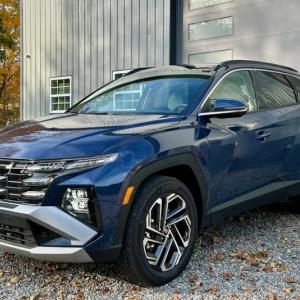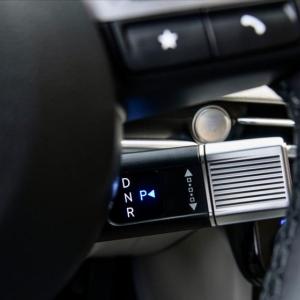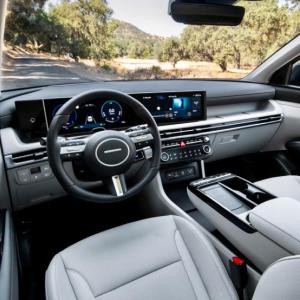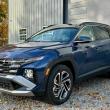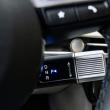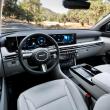Refreshed: Hyundai Tucson Limited AWD
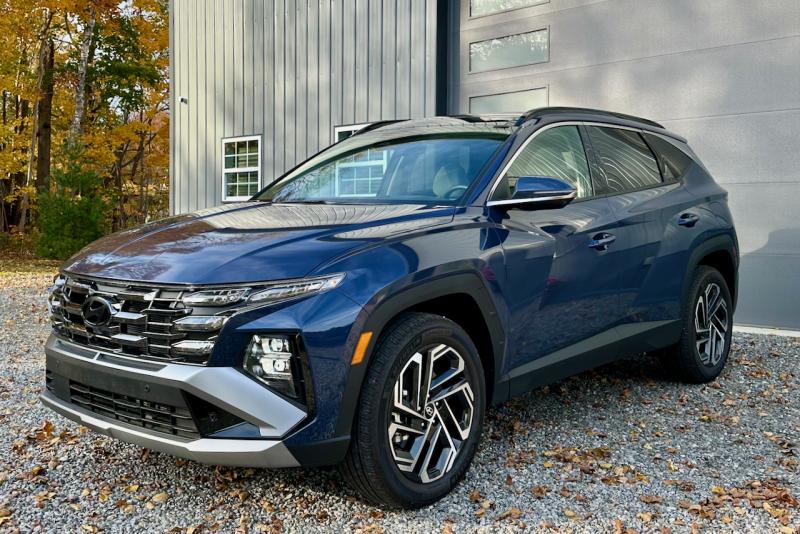 The refreshed-for-2025 Hyundai Tucson is an attractive, roomy, comfortable and well-screwed-together compact SUV with no real flaws and plenty of virtues, not the least of which are good value and Hyundai’s market-leading warranties. This color is Atlantis Blue; the interior is Gray.
The refreshed-for-2025 Hyundai Tucson is an attractive, roomy, comfortable and well-screwed-together compact SUV with no real flaws and plenty of virtues, not the least of which are good value and Hyundai’s market-leading warranties. This color is Atlantis Blue; the interior is Gray.
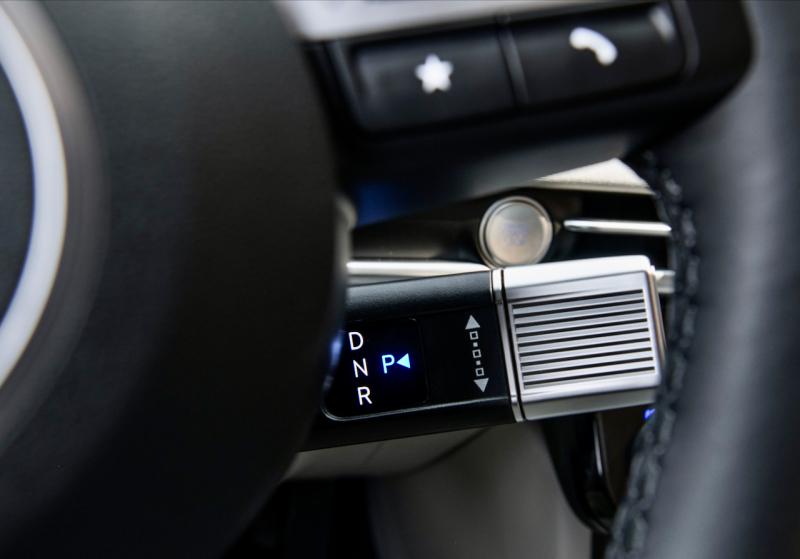 What looks like an oversize control stalk behind the wheel is the Tucson’s new gear selector. Twist the chrome bit toward the front of the car to engage Drive, twist it back the other way for Reverse, and push in on the end of it for Park. It’s surprisingly intuitive, and the e-brake automatically engages at the same time.
What looks like an oversize control stalk behind the wheel is the Tucson’s new gear selector. Twist the chrome bit toward the front of the car to engage Drive, twist it back the other way for Reverse, and push in on the end of it for Park. It’s surprisingly intuitive, and the e-brake automatically engages at the same time.
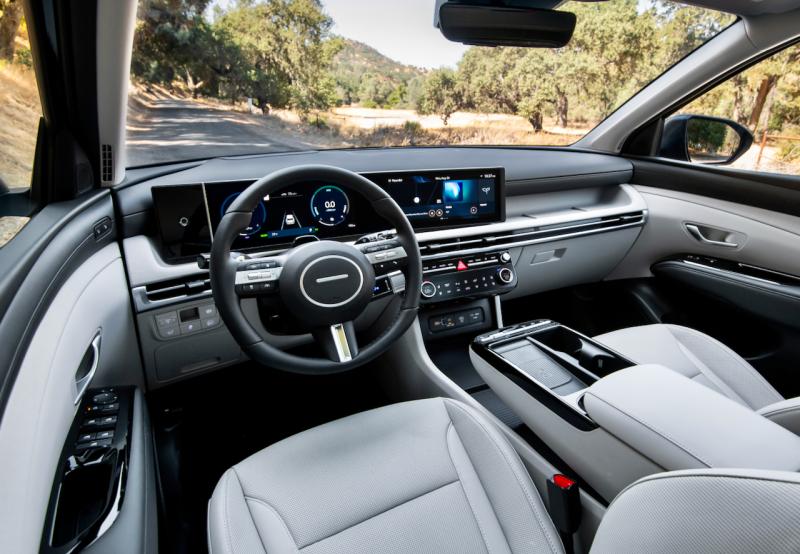 The handsome new-for-‘25 panoramic dashboard is curved toward the driver and features crisp digital displays and intuitive controls. The new center stack below it has real knobs and buttons for manual adjustment of often-used functions, including the audio and HVAC systems. Note also the new storage shelf above the glove box.
The handsome new-for-‘25 panoramic dashboard is curved toward the driver and features crisp digital displays and intuitive controls. The new center stack below it has real knobs and buttons for manual adjustment of often-used functions, including the audio and HVAC systems. Note also the new storage shelf above the glove box.
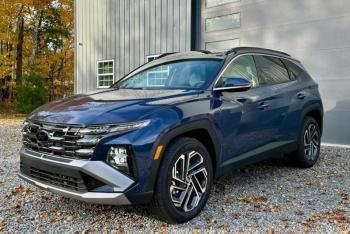 The refreshed-for-2025 Hyundai Tucson is an attractive, roomy, comfortable and well-screwed-together compact SUV with no real flaws and plenty of virtues, not the least of which are good value and Hyundai’s market-leading warranties. This color is Atlantis Blue; the interior is Gray.
The refreshed-for-2025 Hyundai Tucson is an attractive, roomy, comfortable and well-screwed-together compact SUV with no real flaws and plenty of virtues, not the least of which are good value and Hyundai’s market-leading warranties. This color is Atlantis Blue; the interior is Gray.
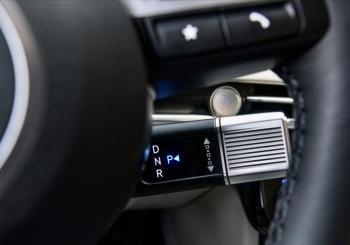 What looks like an oversize control stalk behind the wheel is the Tucson’s new gear selector. Twist the chrome bit toward the front of the car to engage Drive, twist it back the other way for Reverse, and push in on the end of it for Park. It’s surprisingly intuitive, and the e-brake automatically engages at the same time.
What looks like an oversize control stalk behind the wheel is the Tucson’s new gear selector. Twist the chrome bit toward the front of the car to engage Drive, twist it back the other way for Reverse, and push in on the end of it for Park. It’s surprisingly intuitive, and the e-brake automatically engages at the same time.
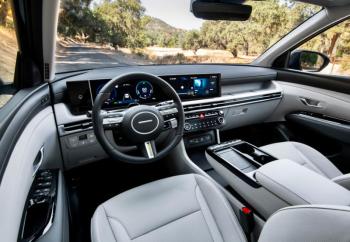 The handsome new-for-‘25 panoramic dashboard is curved toward the driver and features crisp digital displays and intuitive controls. The new center stack below it has real knobs and buttons for manual adjustment of often-used functions, including the audio and HVAC systems. Note also the new storage shelf above the glove box.
The handsome new-for-‘25 panoramic dashboard is curved toward the driver and features crisp digital displays and intuitive controls. The new center stack below it has real knobs and buttons for manual adjustment of often-used functions, including the audio and HVAC systems. Note also the new storage shelf above the glove box.
A Tucson arrived some weeks ago, but it was a leftover 2024 model; the ‘25s were already at Hyundai stores and word was that important changes had been made. So we ignored it and waited, and here’s the pay-off: a shiny, up-optioned 2025 Limited with only 700 miles on it. Ah, that new car smell . . .
Even Tucson owners may have to look closely to see the changes from 2024 to ’25, though. Hyundai has redesigned the grille and the bumpers, and the daytime running-light “signature” has been simplified from 10 small lights to eight larger ones. These alloy wheels are new too, the badges are now anodized aluminum and the rear wiper blade has been lengthened 75 millimeters (nearly three inches), to sweep a larger area for better visibility.
Hyundai says the big changes are on the inside, which has been thoroughly re-done. The most evident upgrade is the new black instrument panel-slash-dashboard, which extends almost two-thirds of the way to the passenger door and curves slightly toward the driver. Built into it, to the right of the digital instruments, is a new infotainment display. An also-new center stack beneath it has real knobs and other switchgear for the audio and climate control systems; there are some redundant controls built into the steering wheel also.
It’s comforting to see carmakers moving away from all touch controls in computer screens—some of them buried under several layers of menus—and going back to actual, physical switches to twirl, push or nudge, at least for commonly used functions. (Now if Mercedes-Benz would only abandon its touchy little sliders . . .)
Here's one example of the evolution of driving technology as found in the 2025 Tucson: Its SCC2—Smart Cruise Control II—not only uses radar to keep itself in line behind the traffic ahead, it is also linked to something called Forward Attention Warning. If this feature detects that the driver is unresponsive, the smart cruise control will bring the vehicle to a stop (in its lane), then flash the hazard lights, set the e-brake and ask whether an SOS call is required.
Alongside this and the other myriad comforts, conveniences, apps and safety systems that come with the Limited trim, our Tucson has the standard 2.5-litre, 4-cylinder gas engine rated for 187 horsepower and 178 pound-feet of torque. It’s the new Tucson’s only shortcoming; even with a well-calibrated 8-speed automatic transmission (with shift paddles and, among other modes, one called Sport) to keep the engine on the boil, the Tucson runs a bit short of steam in passing and merging on the highway. Even so, it is composed and comfortable and almost eerily quiet; and in town the slight want of power is of no concern.
For drivers who want more zip, Hyundai also offers two electrified versions of the Tucson. The straight hybrid mates a 1.6-litre turbocharged gasoline Four with a 47.7-kW electric motor for a total of 231 horses and 258 torques; and the plug-in hybrid Tucson couples the same 1.6-litre engine with a more powerful 72-kW electric motor for a system total of 268 horsepower and 258 torques. Both hybrids have all-wheel drive and 6-speed automatic transmissions; the plug-in has a larger battery pack so that it can run around town on electrons instead of fossil fuel. I expect we’ll get one or the other or both eventually so that we can report on them in greater depth.
A stripped, entry-level, front-wheel-drive Tucson SE lists for an even $30,000 (with freight & handling). Then there’s an SEL version, followed by the SEL Convenience, the XRT and finally the top-end Limited; ours stickers at $41,400, still well below the average new-car price in America today. The hybrids are slightly more spendy—the plug-in version, for example, starts at $40,120 and can go up to $46,845.
‘Opinionated at any Speed’ will return after Thanksgiving.

